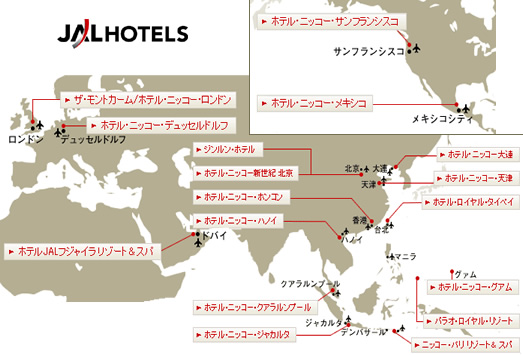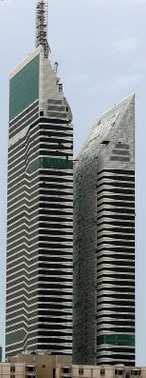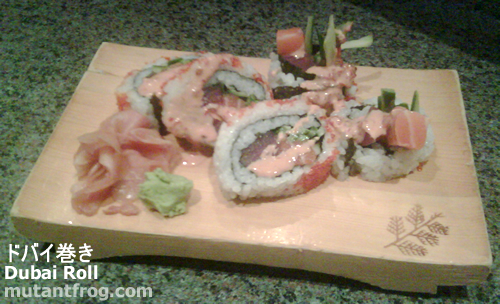Japan Airlines (JAL) is in the hotel business, and not surprisingly, it wants to get out. As the company seeks to restructure itself into a viable business, one of its plans is to sell its hotel arm, possibly to Hotel Okura. JAL currently owns 41 hotels in Japan and 17 overseas, and those overseas hotels are overwhelmingly in large cities — Beijing, London, Mexico City, Hanoi, Hong Kong, and on and on. Others are in tropical resorts popular with Japanese tourists, such as Bali, Palao, and Guam. There is also one JAL hotel in the Middle East, in a somewhat unusual location.

One of these things is not like the other…
The only JAL Hotel in the Middle East is not in a major city such as Dubai, Abu Dhabi, Doha or Beirut. It’s in the tiny emirate of Fujairah, one of the seven emirates that make up the United Arab Emirates, situated not on the Persian Gulf but on the Gulf of Oman. (Don’t rely on the JAL map above for the accurate location — click here for a map that explains where Fujairah is in the context of the other UAE emirates).
The hotel was announced in October 2005 to much fanfare and at that time was scheduled to open in December 2006, with another hotel in Dubai to open in 2007. The JAL Fujairah actually opened in May 2007 — not a bad time lag, actually. The hotel itself is owned by a Kuwaiti company called ACICO — which stands for Aerated Concrete Industries Co., a more old-school construction company that is not a typical player in the luxury hotel business. JAL is the manager of the hotel, and its truly distinguishing characteristic is the cuisine, which is genuinely Japanese and said by some to have some of the best sushi in the entire Middle East. I have heard of more than a few people driving the 2 hours from Dubai to Fujairah just to have a sushi lunch, and then drive home.
Objectively, to international standards, the JAL Fujairah is a beautiful beachside hotel located near a number of other luxury hotels along the Fujairah coast. But locally, I have heard it referred to as a “motel”, and substandard when compared to the other modern luxury coastal resorts in Fujairah such as the Rotana and Le Meridien.
 JAL had bigger plans for the Middle East, and was one of countless companies that got caught up in the Dubai property boom and the hotel boom. But they ran into problems. The Dubai hotel originally announced for 2007 was pushed ahead, and when construction was underway on the JAL Tower, built on prominent real estate along Sheikh Zayed Road, across from the iconic Emirates Towers in early 2007, it was at that time scheduled to be opened in 2008. It was also to be followed by the JAL Hotel and Spa Resort Bahrain in 2009. The later project has since been cancelled, and the former has yet to open as of this writing in early 2010.
JAL had bigger plans for the Middle East, and was one of countless companies that got caught up in the Dubai property boom and the hotel boom. But they ran into problems. The Dubai hotel originally announced for 2007 was pushed ahead, and when construction was underway on the JAL Tower, built on prominent real estate along Sheikh Zayed Road, across from the iconic Emirates Towers in early 2007, it was at that time scheduled to be opened in 2008. It was also to be followed by the JAL Hotel and Spa Resort Bahrain in 2009. The later project has since been cancelled, and the former has yet to open as of this writing in early 2010.
At this point, the cause of the delay is not clear. The tower had just about been completed when I arrived in Dubai last autumn — check out these photos of the building that were taken shortly thereafter — and as of December 2009 it was scheduled to open in April 2010. But it remains closed, and it has yet to open or announce an opening date, only stating on its web page that it will open sometime in 2010. Something must be planned — last month they hired a new director of finance, and last week they hired a new manager, and their web page says they are hiring. But I would be surprised if they opened anytime during the summer months or during Ramadan in August, which means an opening in September at the earliest.
By that time, JAL Hotels may not be JAL Hotels anymore. With a possible sale of JAL Hotel’s assets to Hotel Okura, the first Japanese-managed hotel in the Middle East could be run by a relatively domestic Japanese hotel business. Dubai’s Japanese are hopeful that they can maintain the best sushi in the region.


